
 |
Joe Ross consolidation |
Post Reply 
|
Page 123> |
| Author | |
charlie_8 
Regular 
Joined: 06 Apr 2011 Posts: 21 |
 Post Options Post Options
 Quote Quote  Reply Reply
 Topic: Joe Ross consolidation Topic: Joe Ross consolidationPosted: 19 Sep 2011 at 10:53am |
|
Dear BS Forum Members,
In my Trading I often come back to ideas, that I found in books of Joe Ross. I'm pretty sure, that most of you know, who Joe Ross is (if not, then it is the best time to use googe :D). When I analyse particular stock, I use Ross Trading Software as well as I use Bullcharts. 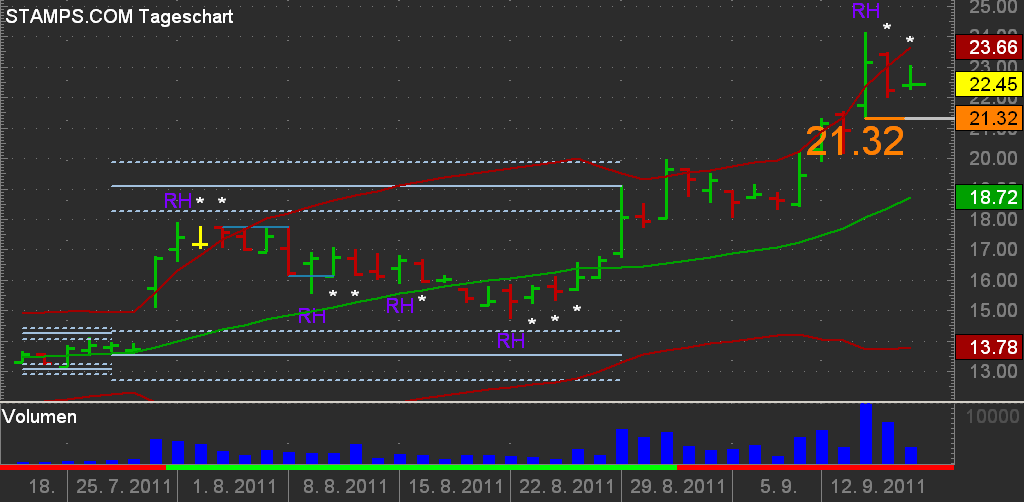 K There are many great setup ideas, that one can find by Mr.Ross and I'm glad to share some of them with you.One of them is consolidation and breakout of consolidation. My description will be very simlifyed, but I'm sure, you will get the point. According to Mr.Ross, consolidation starts (normally) with a bar (called measuring bar (MB)), when this bar is following by at least 4 bars, which opens and closes are within the price range of MB. When we get this situation, we can draw 2 horizontal lines, starting on high and low of the MB. This would be the trading range (TR). The TR exists until we get a bar, that opens and closes outside of trading range. So it is our setup. If this bar broke down of the TR, we will sell on stop placed some ticks under the low of the bar, if there was an breakup, we buy on stop above high of the breakup bar. In my "barbarian" Bullscript it sonds like: HIST(H,4)>O AND HIST(L,4)<O AND HIST(H,4)>C AND HIST(L,4)<C AND HIST(H,4)>HIST(O,1) AND HIST(L,4)<HIST(O,1) AND HIST(H,4)>HIST(C,1) AND HIST(L,4)<HIST(C,1) AND HIST(H,4)>HIST(O,2) AND HIST(L,4)<HIST(O,2) AND HIST(H,4)>HIST(C,2) AND HIST(L,4)<HIST(C,2) AND HIST(H,4)>HIST(O,3) AND HIST(L,4)<HIST(O,3) AND HIST(H,4)>HIST(C,3) AND HIST(L,4)<HIST(C,3)  Maby somebody could help me to make such one indicator correctly? I mean on the price pane, with 2 horizontal lines, that end after breakout bar. And maby with price leves like by Darvas boxes? Sure this concept could be refine, for exampe, you will see very often doji bars as breakout bars - maby it would be clever not trade them? Or you could switch to higher timeframe to decide if particular parket is in trend or in consolidation and place the order based on your view of situation. Or when next day will open with gap, not try to catch the market? Mr.Ross never make a trade, if he sees a gap! It would be very nice to hear feedback about this setup! And any help by creating such indicator will be very appreciated. I wish all of you good trading! Edited by charlie_8 - 20 Sep 2011 at 6:53am |
|
 |
|
cmacdon 
BullCharts Guru 
Joined: 09 Sep 2012 Location: Brisbane Posts: 236 |
 Post Options Post Options
 Quote Quote  Reply Reply
 Posted: 16 Dec 2012 at 3:18pm Posted: 16 Dec 2012 at 3:18pm |
|
charlie-B
As discussed in private email I will post somewting under the stepped price post to provide perhaps a better outcome Charles
|
|
|
BC User since June 2007
|
|
 |
|
charlie_8 
Regular 
Joined: 06 Apr 2011 Posts: 21 |
 Post Options Post Options
 Quote Quote  Reply Reply
 Posted: 17 Dec 2012 at 3:12am Posted: 17 Dec 2012 at 3:12am |
|
Thank you for the answer Charles!
I think, I'll try explain this concept of consolidation and how I use it in my trading in more detail. My writing skills in English are far away from perfect, so I`m sorry for that and will try my best hoping that my post will be easy to read. In my trading I tried to find the way, where I not have to use any technical indicators or predict any swings / reversal. I dont use VSA and dont pay any attention to volume, although I have read Wycoff's Trading Course, "Mastering the Markets" and both Volumes of Gavin Holmes. I found it very useful for expressive explanation of the past (like Gavin does it on YouTube), but not for making any decisions for the future price action. In most cases, using classical methods of support / resistance levels and HH / LL one would achieve same results (if not better), than using VSA without facing what I called for me the TMI problem (Too Much Information). It means, that if we incorporate in our decision making more and more logical steps (entities) with more then one possible outcomes, we have to summarize and weight all the possible outcomes, what in turn makes desicion makig much complcated. But equity markets are simplier: they go up or down or sideways. (About misleading volume data one may find this article interesting: http://articles.businessinsider.com/2011-01-04/markets/30003404_1_stock-market-technical-analysis-trading-system). I also bought this book of Grimes because I found there some price action ideas close corresponding to mine. So I'm seekeng simlicity, but one, that based on the market reality. For me the only market reality that we have is the market price. A particular market goes higher, because price breaks high(s) of previous bar(s) and from time to time in strong uptrends bars will close higher, than high(s) of previous bar(s). A particular market goes lower, because price breaks low(s) of previous bar(s) and from time to time in strong downtrends bars will close lower, than low(s) of previous bar(s). (It seems to be obvious, but many traders tend to use moving averages instead of that simple observation). And theres is time, when a market gose nowhere, and the it is worth to take a closer look to this market. Quite simple, isn't is? But what does it mean, that the market goes nowhere? If you goolgle "consolidation" or "trading range" you would find pictures with price bars (or candlesticks), that fluctuate building swings and pivot points mostly between two horizontal boundaries. But I trying to exclude swings from my trading because they are highly unpredictably. So I searched for the way, where I could to determine the volatility contraction without paying attention on swings, misleading boundaries and otherways without using indicators like Bollinger Bands or any mean reversion volatility concepts. And one day I read in one of Ross's book about how he determine the consolidation. It is not his core conceps like 1-2-3 Formations or hooks, therefore it took some time before I started to watch this idea somtig deeper. Take a look on the monthly chart of LNC (the same stock that you Charles used for introducing stepped indicator): 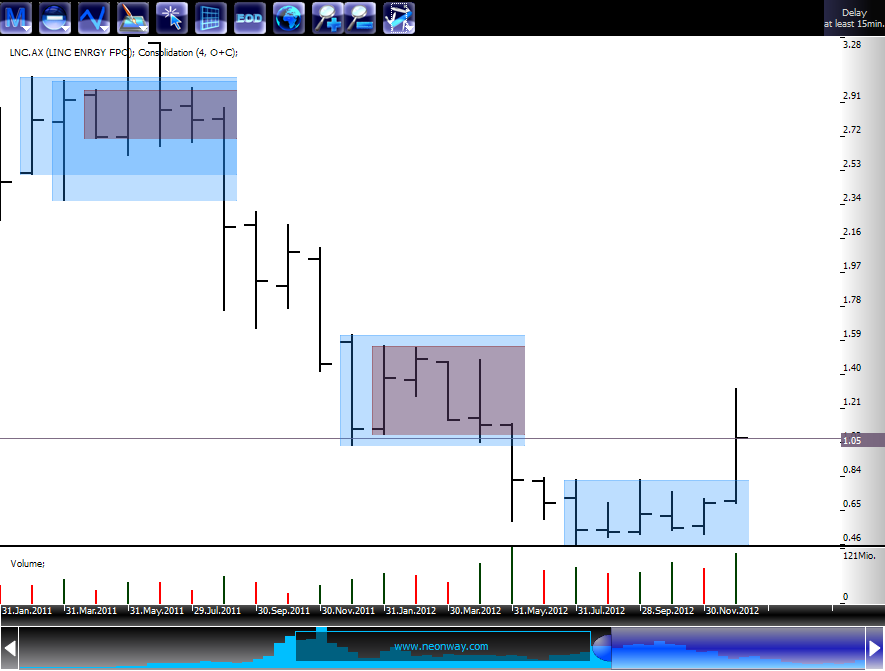 We see, that after volatility exansion (trend), we see at least 4 bars, that open or closes, or open and close within the range of the bar (no hard boundaries), that called "measuring bar" and it is the end bar of volatility expansion. Let's us take a look on the whole history of LNC (that I have). 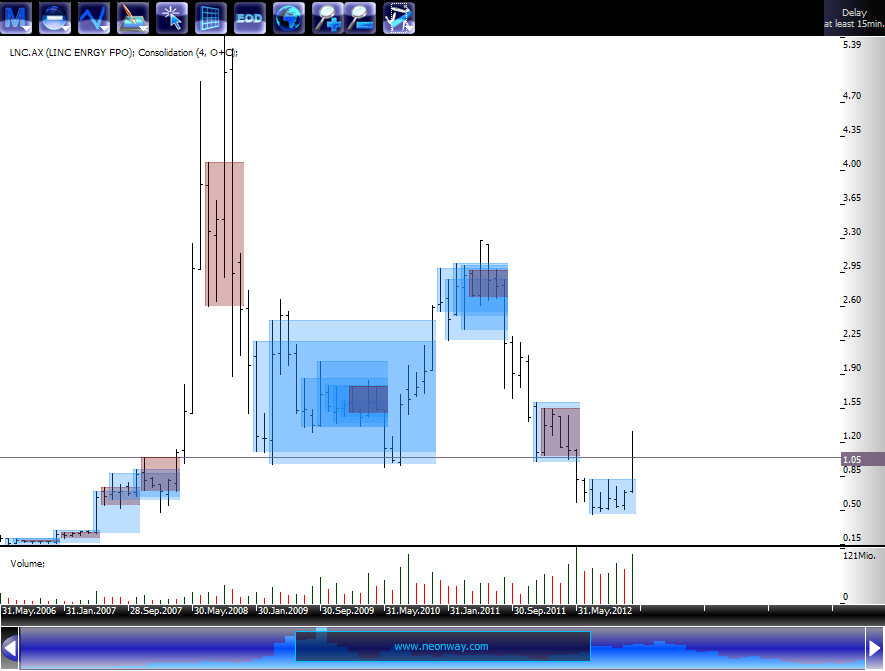 So what is the simliest way to trade volatility expansion? Let's zoom the year 2007. 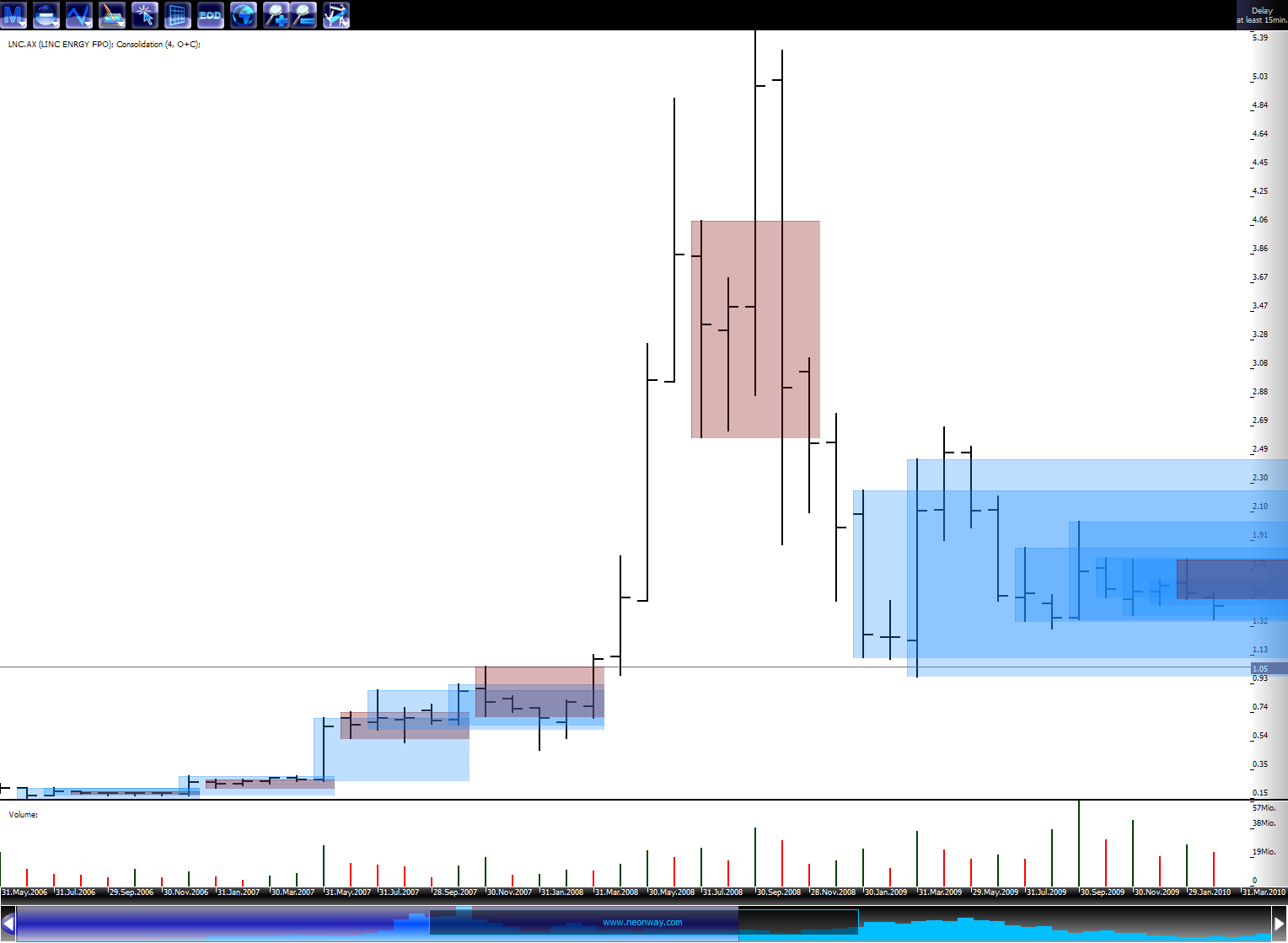 I'm using mutiple timeframes for analysis and trading. So if I see an consolidation on Monthly graph, I would search for entries on Weekly (may be also Daily) timeframe. There are many possibilities to step into position, but the simpliest one would be to go with the market after first correction after breakout. 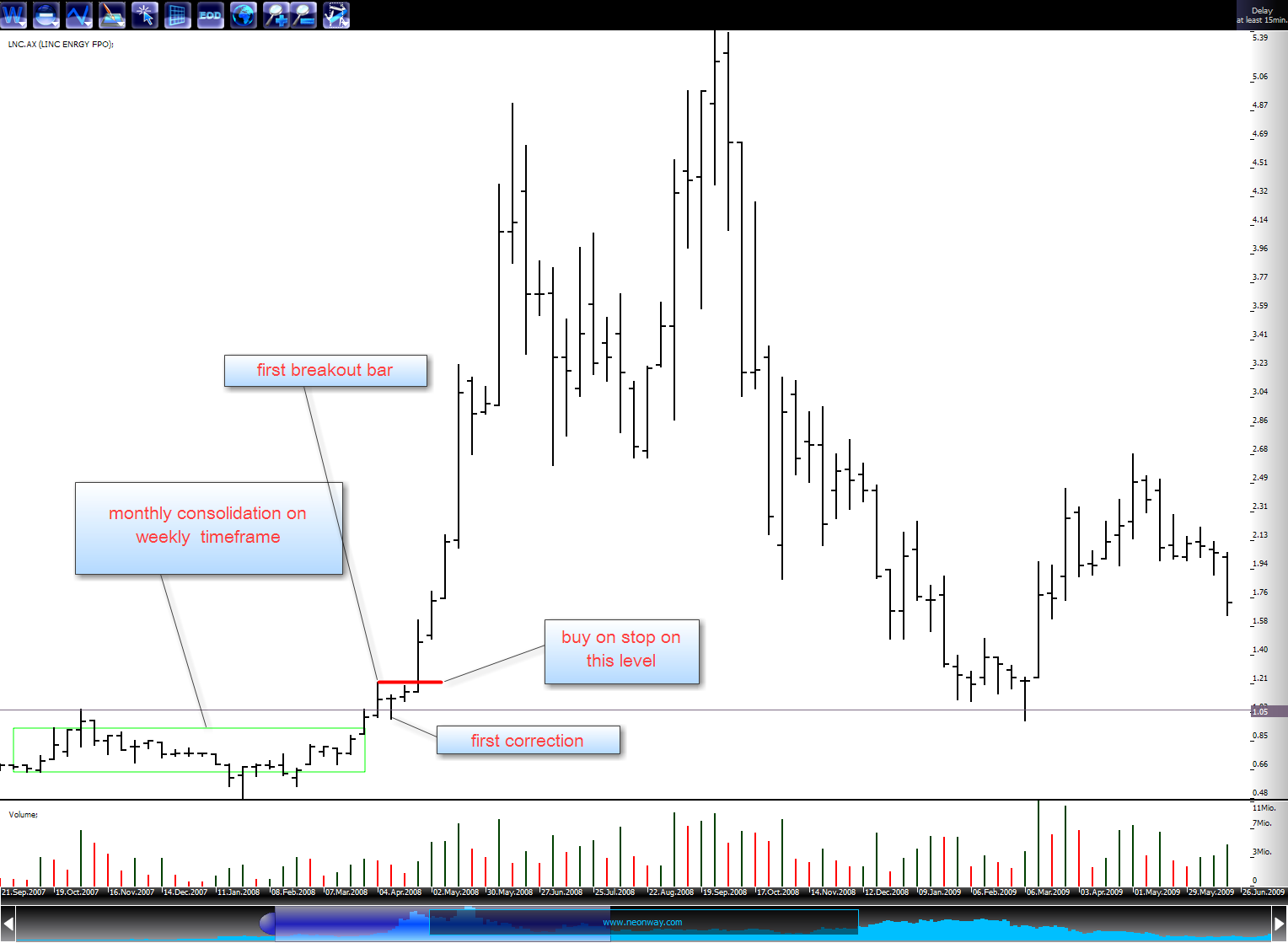 As iI said, this is the simpliest way to step into position. So I only described here the core idea of trading of such kind of volatility expansion. If someone would find it interesting or useful, feel free to post suggestion / question to me.  |
|
 |
|
cmacdon 
BullCharts Guru 
Joined: 09 Sep 2012 Location: Brisbane Posts: 236 |
 Post Options Post Options
 Quote Quote  Reply Reply
 Posted: 17 Dec 2012 at 4:22pm Posted: 17 Dec 2012 at 4:22pm |
|
Charlie-B
As previousyl advised I no nothing about Joe Ross but reading what you are trying to do I did a version 1 whichemulates the original code you provided using all AND statements similar to you code but that chart does not emulate the one you sent through for LNC so I think your original code may not be correct. Your original code is suggesting both the open and the close of bars 2, bar 3 and bar 4 should be within the range of bar 1 yet if you look at the reddish box on the monthly chart of LNC you provided some bars have opens and closes outside of the range 1 bar. Consequently I changed that version code to use OR statements i.e. either the open or the close of bars 2 and bar 3 and bar4 should be within the range of bar 1, and this appears better so I providede that code below. If you correctly the code let us know. When putting on the indicator, go into the advanced Tab abd put -4 in the Horizontal shift box and it locks the fill to the relevant bar 1. In the Style box for the fill tick the stepped option With the way the Horz step works it does not truncate after 4 bars but I am not sure that is a big hindrance when looking at the chart and helps show the breakouts I will post two charts the origtinal using AND in Code and the second version using OR as set out below Charles [Description ="Joe Ross Consolidation Draft 1"] [target =price;] a:= If(((O<Hist(H,4) and O> Hist(L,4)) OR (C<Hist(H,4) and C> Hist(L,4))) AND ((Hist(O,1)<Hist(H,4) and Hist(O,1)> Hist(L,4)) OR (Hist(C,1)<Hist(H,4) and Hist(C,1)> Hist(L,4))) AND ((Hist(O,2)<Hist(H,4) and Hist(O,2)> Hist(L,4)) OR (Hist(C,2)<Hist(H,4) and Hist(C,2)> Hist(L,4))) AND ((Hist(O,3)<Hist(H,4) and Hist(O,3)> Hist(L,4)) OR (Hist(C,3)<Hist(H,4) and Hist(C,3)> Hist(L,4))),1,0);
{ Top Line} [name =Top line; linestyle=Horz Step; color=Black; width=1] JRH:= If((a=1),Hist(H,4) ,Undefined); JRH; { Bottom Line } [name =Bottom Line; linestyle=Horz Step; color=Black; width=1] JRL:= If((a=1),Hist(L,4),Undefined); JRL; { Infill colour on Trends } [name =VFill colour; linestyle=fill] [color =Green] Valuewhen(1,JRH,Hist(H,4)); [color =Green] Valuewhen(1,JRL,Hist(L,4)); |
|
|
BC User since June 2007
|
|
 |
|
cmacdon 
BullCharts Guru 
Joined: 09 Sep 2012 Location: Brisbane Posts: 236 |
 Post Options Post Options
 Quote Quote  Reply Reply
 Posted: 17 Dec 2012 at 4:23pm Posted: 17 Dec 2012 at 4:23pm |
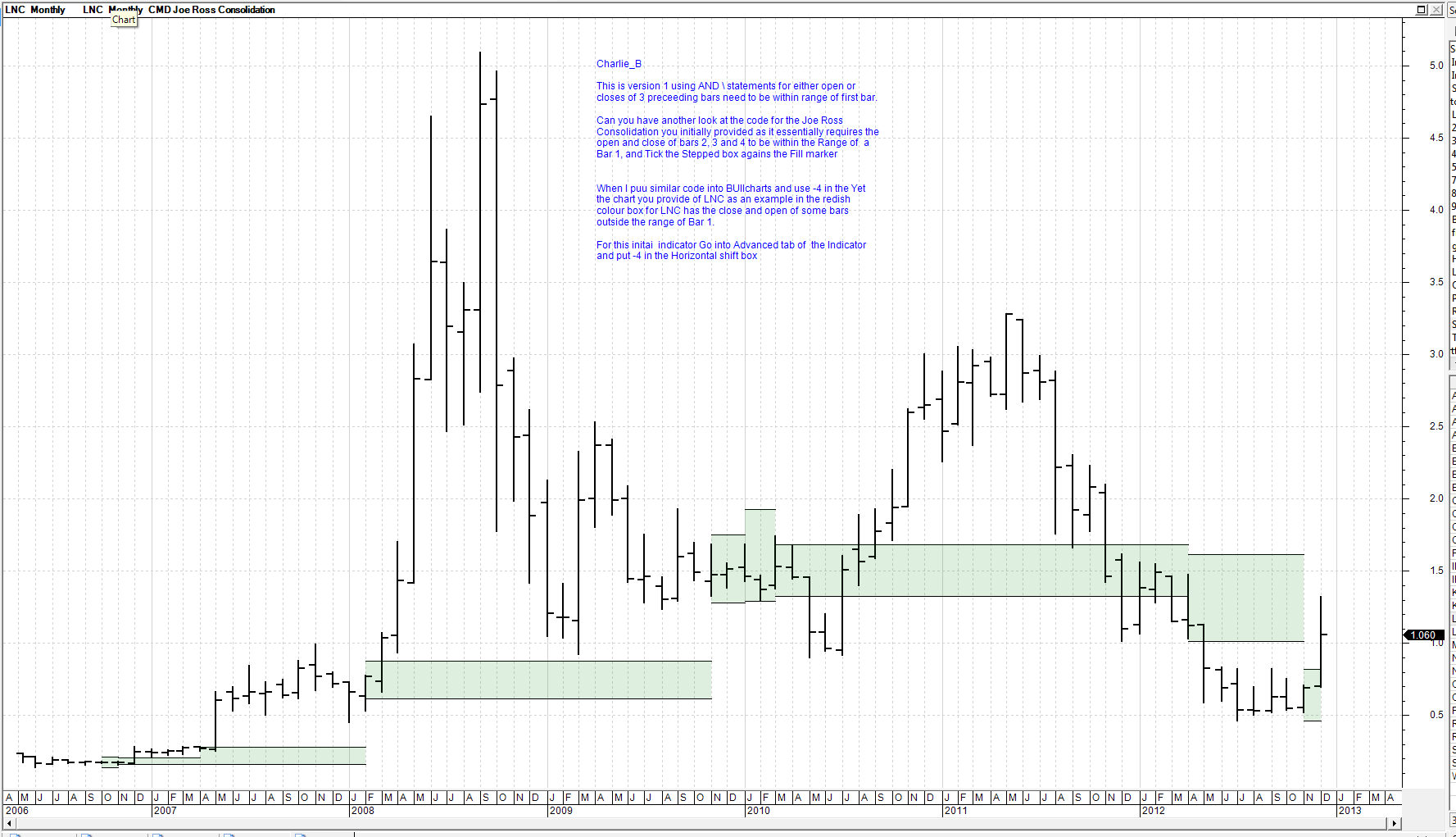
|
|
|
BC User since June 2007
|
|
 |
|
cmacdon 
BullCharts Guru 
Joined: 09 Sep 2012 Location: Brisbane Posts: 236 |
 Post Options Post Options
 Quote Quote  Reply Reply
 Posted: 17 Dec 2012 at 4:24pm Posted: 17 Dec 2012 at 4:24pm |
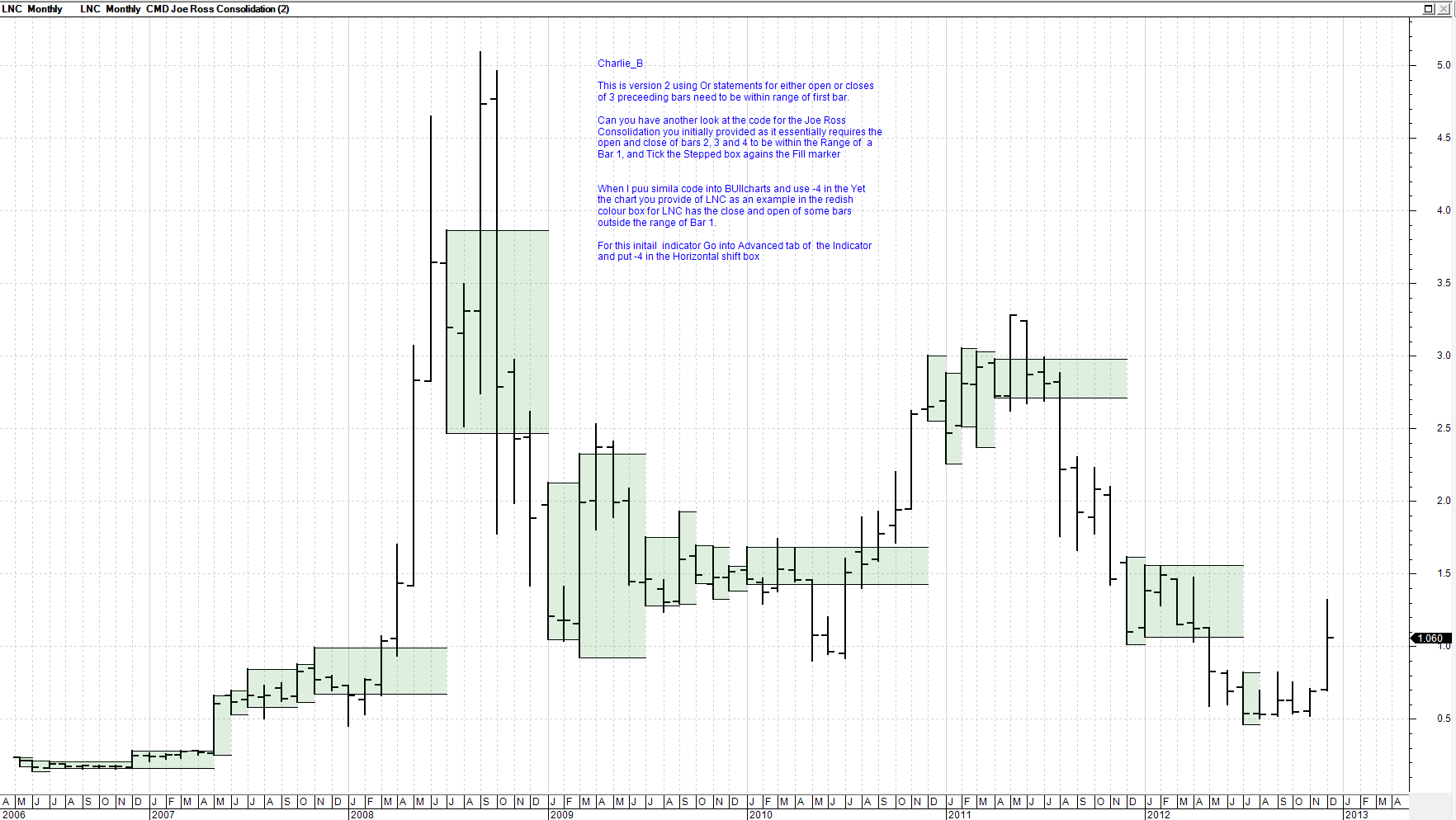
|
|
|
BC User since June 2007
|
|
 |
|
charlie_8 
Regular 
Joined: 06 Apr 2011 Posts: 21 |
 Post Options Post Options
 Quote Quote  Reply Reply
 Posted: 17 Dec 2012 at 6:58pm Posted: 17 Dec 2012 at 6:58pm |
|
umfortinatly the code in my first post wasn't coorect, I saw it some time after I allready posted it. But becaise nobody has answered, I forgot about this. I'm sorry for that. I will try to explain the construction of such consolidadion soon in my new post.
|
|
 |
|
charlie_8 
Regular 
Joined: 06 Apr 2011 Posts: 21 |
 Post Options Post Options
 Quote Quote  Reply Reply
 Posted: 21 Dec 2012 at 3:03pm Posted: 21 Dec 2012 at 3:03pm |
|
Before we can start to dicuss consolidation (or volatility contraction area), let me show you the paintjob, that I made in MS Word. It shows us some posibilitis of price behavior within the area if consolidation:
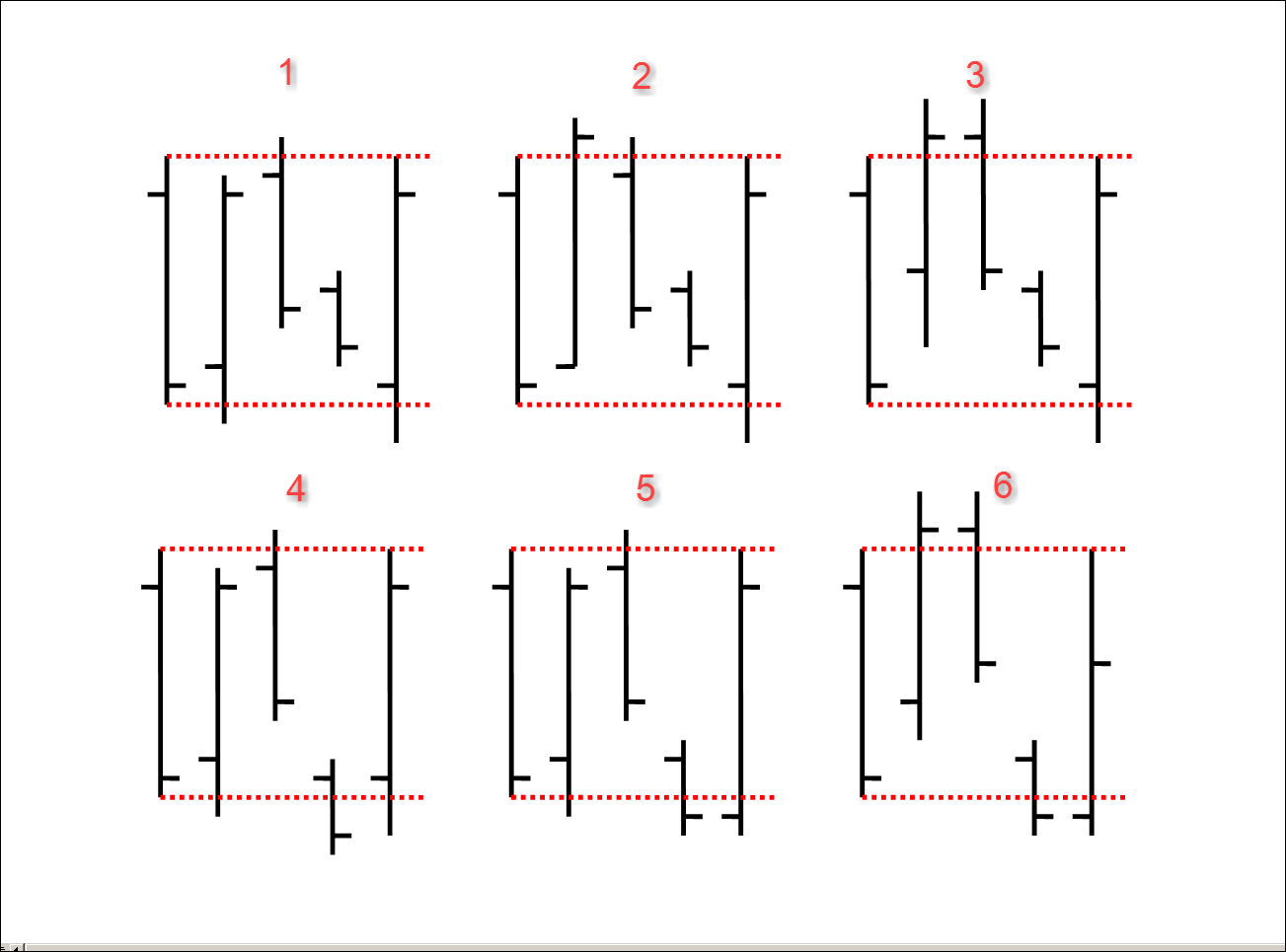 I painted 6 cases in total with the goal to show you some possibilities of price distribution in consolidation. There are only painted examples for you to make the idea clear. Every first bar in each exampe of consolidation is called "measuring bar". In some cases it is a long bar, that often comes on the end of market movement. This bar measures the trading range (dotted red lines). For completing of a consolidation we need to see such measuring bar and at least (its a minimum number) 4 following bar with O and C of each bar inside of the range of measuring bar (H and L breakouts don't matter) - like in the CASE 1, or only O or C of any of those 4 bars within the range of the measuring bar (like in CASES 2 to 6). Again, H and L of any bar could penetrate the trading range of a measuring bar, and this particular bar could also close outside of trading range. Very next bar could also opens outside consolidation, but only if this bar closes outside trading range, we can say, that consolidation is broken. 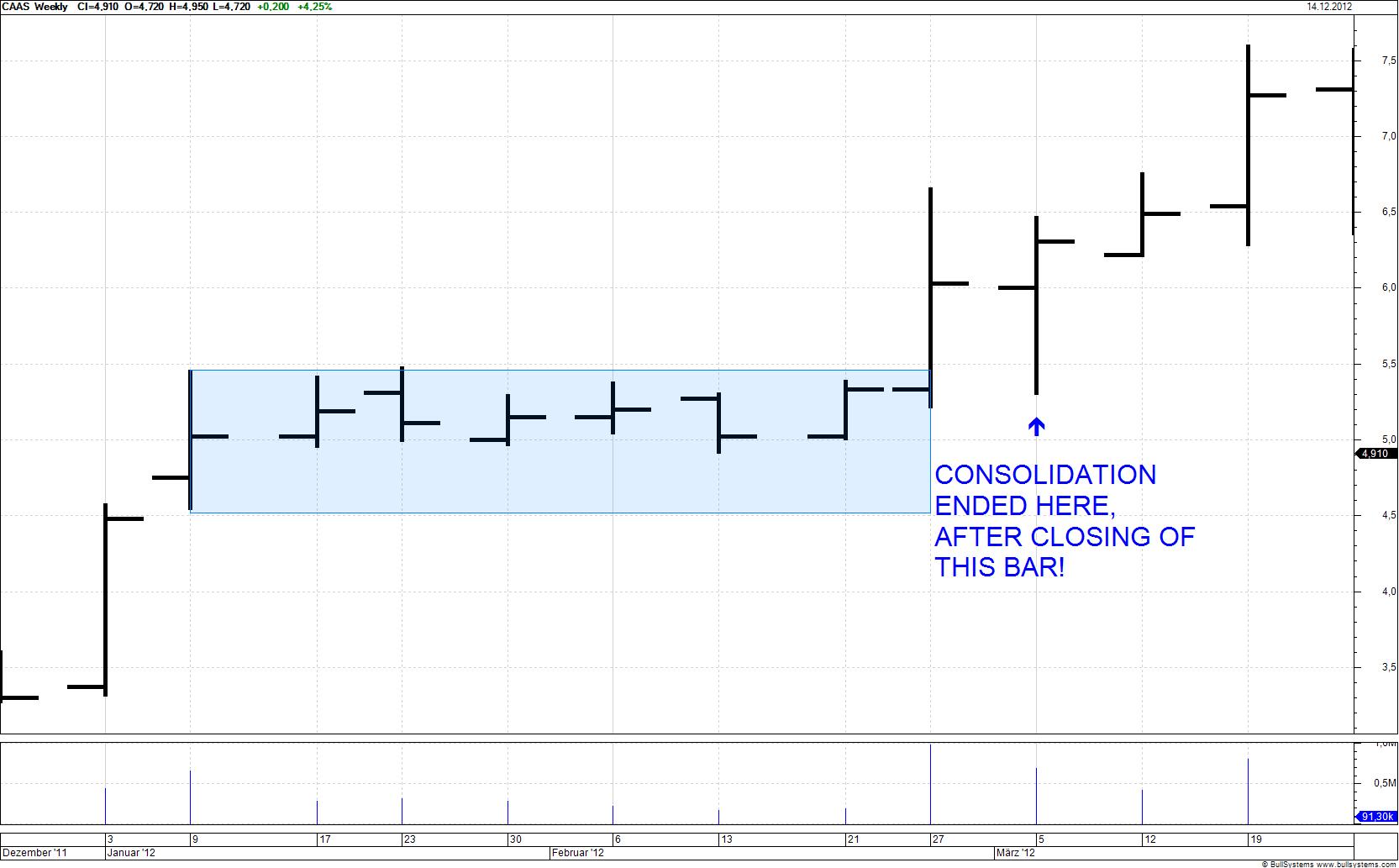 Inside of showed consolidation on CAAS are 2 other consolidations (I just didnt painted them)!  This was a theoretical part so far. I'll show some practical examles in my next post. Edited by charlie_8 - 21 Dec 2012 at 3:20pm |
|
 |
|
cmacdon 
BullCharts Guru 
Joined: 09 Sep 2012 Location: Brisbane Posts: 236 |
 Post Options Post Options
 Quote Quote  Reply Reply
 Posted: 21 Dec 2012 at 3:30pm Posted: 21 Dec 2012 at 3:30pm |
|
Charlie-B
I downloaded some Joe Ross stfuff from internet and willl have a look at over the weekend. There seems to be a lot of writings. What particuloar references and pages of his work are you using? Charles
|
|
|
BC User since June 2007
|
|
 |
|
charlie_8 
Regular 
Joined: 06 Apr 2011 Posts: 21 |
 Post Options Post Options
 Quote Quote  Reply Reply
 Posted: 22 Dec 2012 at 5:32am Posted: 22 Dec 2012 at 5:32am |
|
Charles, could you please tell me what did you habe already downloaded? I read almost everything from him, but mostly in German.
|
|
 |
|
Post Reply 
|
Page 123> |
| Forum Jump | Forum Permissions  You cannot post new topics in this forum You cannot reply to topics in this forum You cannot delete your posts in this forum You cannot edit your posts in this forum You cannot create polls in this forum You cannot vote in polls in this forum |